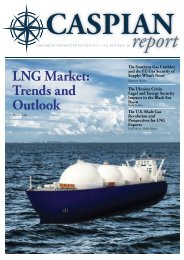Caspian Report - Issue: 07 - Spring 2014
Create successful ePaper yourself
Turn your PDF publications into a flip-book with our unique Google optimized e-Paper software.
The expanded role for natural gas in the<br />
world economy has prompted the IEA to<br />
envisage a “Golden Age of Gas” era with<br />
unconventional gas being a “game changer.”<br />
Introduction<br />
The U.S. shale gas development is not<br />
a technical revolution, but rather an<br />
evolution of modern techniques and<br />
the combining of two key technologies<br />
– horizontal drilling and “slick<br />
water” hydraulic fracturing. Together<br />
these can crack shale rock, and have<br />
thus cracked the code with regard to<br />
opening up major North American<br />
shale gas resources.<br />
The rapidly expanding production<br />
of shale gas has transformed the U.S.<br />
from the largest LNG import market<br />
to a self-sustaining gas producer and<br />
a net gas exporter. In 2009, the U.S.<br />
even overtook Russia as the world’s<br />
largest gas producer, and in 2010 it<br />
exceeded Qatar as the world’s largest<br />
LNG exporter by about 60%. In 2012,<br />
U.S. natural gas production increased<br />
to 681.4 billion cubic meters (bcm;<br />
20.4% of the global production),<br />
whereas Russia’s was just 592.3 bcm<br />
(17.6% of global production).<br />
The combination of three factors -<br />
(1) a drop in demand linked to the<br />
global economic recession, (2) a<br />
unexpected dramatic increase in<br />
incremental U.S. non-conventional<br />
shale gas production, and (3) the<br />
arrival of new LNG delivery capacity<br />
- have created a sudden “gas glut”.<br />
This stems from the overcapacity<br />
of LNG, which made LNG in Europe<br />
less expensive than pipeline gas<br />
(based on long-term contracts), and<br />
contributed to the de-linkage of the<br />
gas prices from the oil prices in at<br />
least Europe at present. This could<br />
become a permanent feature of the<br />
global energy market because the<br />
remaining global unconventional<br />
gas resources are considerably bigger<br />
than conventional ones. The U.S.<br />
could even overtake Russia as the<br />
world’s largest combined oil and gas<br />
producer by 2015.<br />
The development of unconventional<br />
gas in the U.S. since 2006 has not<br />
only triggered a revolution in U.S.<br />
energy markets, but has also laid the<br />
groundwork for an expanded role<br />
for natural gas in the world economy.<br />
This has prompted the IEA to envisage<br />
a “Golden Age of Gas” era with<br />
unconventional gas being a “game<br />
changer.” It has already transformed<br />
the global gas markets, which were<br />
in the past “sellers’ markets” rather<br />
than “buyers’ markets.”<br />
Meanwhile, some countries in Europe<br />
(Poland, United Kingdom, Romania,<br />
Lithuania, Spain and Ukraine)<br />
have become very interested at the<br />
65<br />
CASPIAN REPORT, SPRING <strong>2014</strong>










